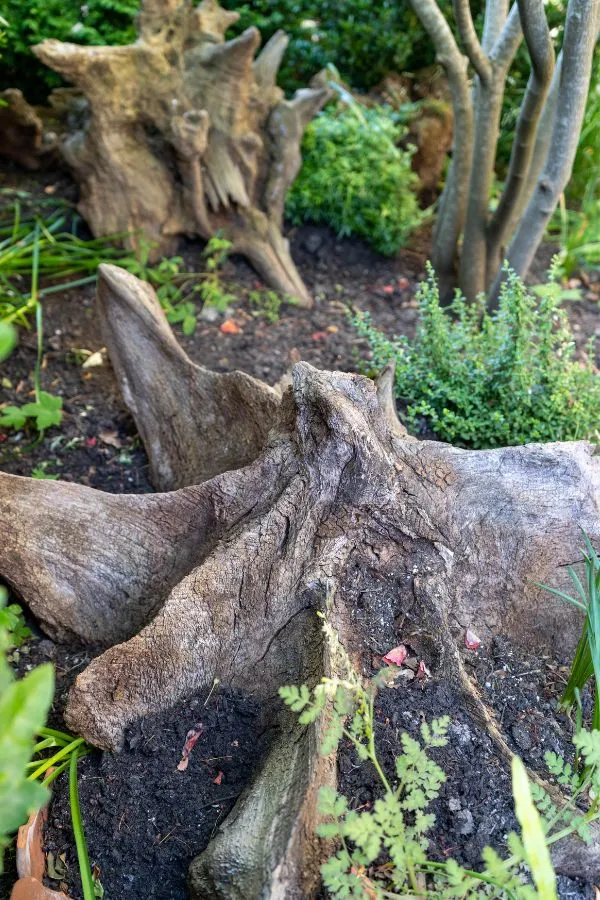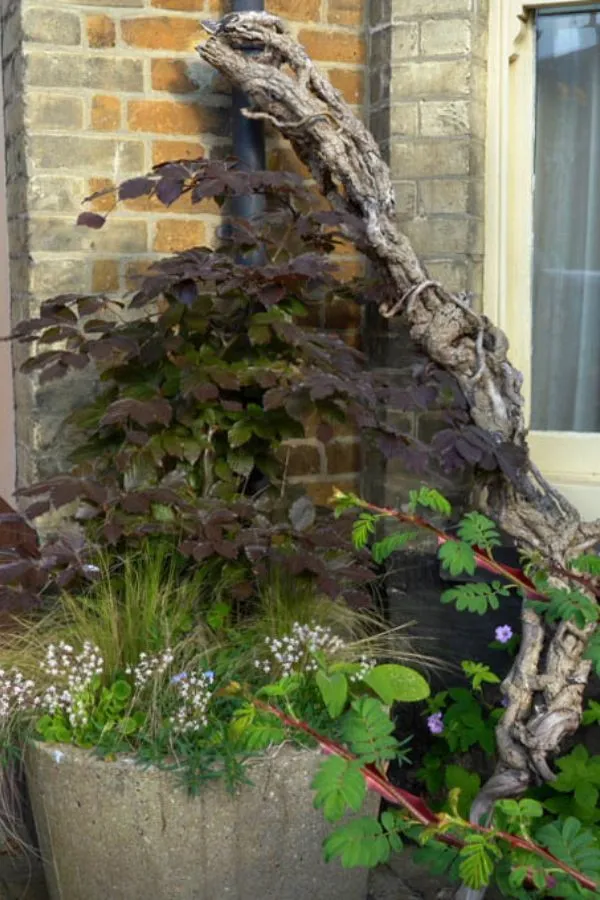A stumpery is an area of the garden with tree stumps and logs arranged as decoration. If you’ve got a mature tree with big roots and you can’t plant anything near it, then a stumpery is an interesting and attractive option.
It’s sometimes described as ‘a rock garden created with tree stumps.’ Perfect for a shady slope or corner, it can be based around a tree or tree stumps, either fallen or still in the ground.
The stumpery was a Victorian garden design trend. It’s now making a comeback, because it’s environmentally friendly and wildlife friendly.
The new stumpery at Doddington Place Gardens, based around a dead tree and a dip in the ground.
The first one I ever saw was at Highgrove in the early 1990s. The then Prince Charles was spear-heading environmentally friendly gardening. I was with a group of journalists and we were (literally) stumped when we came across a clearing with stacks of tree stumps piled on top of each other, almost forming a wall.
Garden designer Posy Gentles’ front garden bed is 1.5m x 2.5m and is shaded by a wall, a hedge and a multi-stemmed tree. So she has created a mini-stumpery to show off shade-loving small plants.
Lucy Adams and Adam Roberts, gardeners at Doddington Place Gardens in Kent, have just finished creating a stumpery in a dip in the ground. And garden designer Posy Gentles has also created a mini stumpery in her front garden in town. So here are their tips.
What are the benefits of a stumpery?
If you have a dead tree or old logs and stumps hanging around your garden, then making them a decorative part of the garden saves you time, effort and money. You won’t pay to have them stump-ground or taken away.
Even if you have a dead tree or a tree stump still in the ground, that can be the focus for a stumpery.
Group logs and tree stumps around tree roots to create a stumpery. This one at Doddington Place Gardens also makes sense of a natural dip in the ground.
Dead wood is beneficial to insects and the wildlife that feed on the insects, which makes it environmentally friendly.
A stumpery is also an interesting way to treat a difficult shady corner. If, for example, you have a part of your garden that is heavily shaded by trees, with tree roots growing in it, then it’s an attractive way of dealing with an area that can be difficult to plant.
Where do you get logs or stumps from?
If you don’t have access to fallen trees, then ask local tree surgeons or arborists, search ‘tree stumps for sale’ online and ask at garden centres, nurseries or gardens that are regularly open to the public.
Doddington Place Gardens is part of an estate, says Lucy. ‘So we had lots of tree stumps around.’
Most of these are from fallen trees. Adam says that digging up a tree stump would be a long hard job. And Lucy adds that you wouldn’t know if it had an attractive root formation until you had dug it up. ‘The advantage of using tree stumps from fallen trees is that you can see the shapes they make.’
Tree stumps from fallen trees show the architectural shapes of their roots. If you dig a stump up, it will be very hard work and you won’t know what the shape is beforehand.
You don’t always need a whole tree stump. Several of Posy Gentles’ stumps are only a part of a stump.
Lucy warns that you can’t simply take a fallen tree stump if you find it lying around when you’re out walking. ‘All land is managed or owned by someone. You need to contact them, whether it’s a private landowner or the forestry commission. But you may find them surprisingly helpful!’
It’s also worth remembering that you will probably need special equipment or help to move a larger stump. ‘We could move some smaller ones by hand and wheelbarrow,’ said Lucy. ‘But we had to hire special equipment to move the really big ones.’
How to place stumps
There’s no special way of placing tree stumps in a stumpery.
Both these stumperies – at Doddington Place Gardens and in Posy’s front garden – were inspired by the stumpery at Highgrove House in the Cotswolds.
The then Prince Charles created it in the early 1990s, when it was a very unusual feature. It has tree stumps stacked one on top of the other, almost like a wall of tree stumps.
However, at Doddington Place Gardens, they placed the tree stumps spaced apart, to show off their sculptural qualities. ‘Although we had to place the biggest ones in places that could be accessed by the equipment,’ adds Lucy.
At Doddington Place Gardens the stumps are placed to show off their architectural shapes.
Posy also placed stumps where she thought they looked best.
How deep should you plant the stumps?
Posy’s stumps are simply placed on the ground. It’s flat, so there’s no likelihood that they could move or fall.
One reason why she wanted to use the stumps was to create extra height to showcase the plants. So she built up the soil around them to create an extra planting space.
However, rain washed the soil away! So she wedged some slates in around them to hold the soil in place and planted them up there.
You can barely see the old slates pushed in to hold the extra soil in place. You could also use pieces of broken pottery.
When you have more of a slope, some people recommend planting around one third of the stump in the soil to keep it in place.
How to create a small stumpery
Posy’s front garden stumpery is around 1.5m x 2.5 m, so it’s a very small area. She has a multi-stemmed amelanchier tree in it, which provides privacy for the house. This means that the rest of it is in shade during the summer.
The multi-stemmed tree is the largest element in this small space, so she placed two largest stumps furthest away from it on either side to balance out the shape. ‘Think of it like decorating a corner in your house. If you have a picture, a table and a lamp, they all create an overall shape together. The tree and the stumps have a similar relationship to each other.’

Posy balanced the major elements in the small space by placing the two largest stumps in a triangle with the stems of the amelanchier tree.
Otherwise you can place the stumps wherever you like.
Small stumpery ideas
You could have a ‘mini stumpery’ with just one stump. Lucy thinks that adding a stump to, say, a mini pond or in a wildlife corner, would look good and create a habitat.
In Jo Richardson’s garden, she has several tree stumps planted up with succulents. However, she keeps these in the sun, because succulents need sunshine.
Jo Richardson has used a tree stump for planting succulents – though you would have to place it in a sunny spot. See more of Jo’s garden ideas in Starting a Garden From Scratch.’
You can use tree stumps still in the ground as starting point for a stumpery theme. Add bug hotels, log piles, a dead hedge and other tree related items, as in this show garden for the Royal Entomological Society at RHS Chelsea Flower Show 2023.

Expand on the tree theme with trees in pots or dead logs. This copper beech is in a pot in Posy’s garden, with a log arranged beside it.
How to plant a stumpery
Posy’s town garden is flat, so she uses the tree stumps to create some height. This means she can show off small, individual plants that would get lost in a border. She has planted it up with small daffodils and tulips in spring. She’s also found tiny-leafed versions of ivy and euonymus.
In Posy’s mini stumpery, she has planted plants with tiny leaves and miniature bulbs. She says that she did plant some larger daffodils, but they looked wrong so she had to take them out. ‘It’s a place to showcase small plants that would get lost in a border,’ she says.
If you’re planting under deciduous trees, then it’s a very good place for bulbs. Deciduous trees lose their leaves in winter, so spring bulbs get the early sunshine.
If you’re planting under evergreen trees, that is much harder. Very little will grow directly under an evergreen tree. But you can prune evergreens to allow more light in.
Stumperies are good place for ferns and woodland plants. At Doddington Place Gardens, they have used ferns for their sculptural qualities.
At Doddington Place Gardens, they have planted ferns, spring bulbs, cowslips and cyclamen. It’s worth trying any shade loving plants with shallow roots.
Other sloping garden solutions
A stumpery doesn’t have to be on a slope, but it’s a good option for a shady slope or one with lots of trees. If you have a sunny slope, then consider creating a rock garden.
Can you plant around tree roots?
I sometimes get queries from people wondering what they can do when mature tree roots are growing on the surface in their gardens.
Don’t try to cover up or cut back tree roots. Both could damage the tree. It would be better to make the roots central to the theme in that part of the garden, perhaps creating a mini stumpery or adding a log pile in the area. And you can plant around the roots, although it’s not suitable for lawn as you won’t be able to cut it.
Lucy says that, firstly, you should think about which side of the tree is sunnier or shadier when you’re choosing plants. Both sides will be in at least partial shade but one side will probably have more sun than the other. That will affect your plant choice.
The best plants to plant around tree roots are bulbs, ferns and cyclamen, say Lucy and Adam. Or try any plants with shallow roots which are happy in the shade.

Leave a Reply